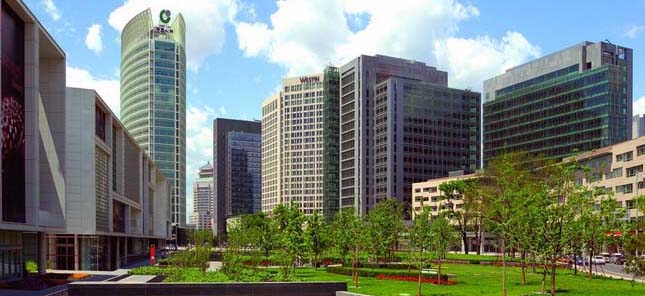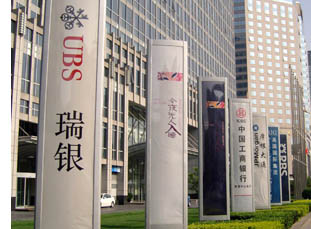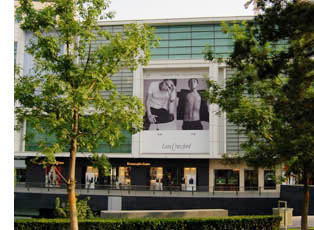A City Off Balance, Beijing Moves West of Tiananmen

BEIJING, June 12 – Beijing has seen massive development in the last 20 years. International five-star hotels, Oriental plaza, Wangfujing, the central business district, SoHo, the Shangri-La-owned China World Complex, and many others area of note, all have sprung up on the east side of the city. All of this development on the east side of Beijing has meant that Tiananmen Square is no longer the center of the city. This has been a major issue now for some time amongst city planners and the traditional Chinese feng shui experts who are concerned about city harmony and the traditions of old Beijing.
Historically, the western side of Beijing was reserved for nobility. Minor royalty, advisors to the court, favored artisans, painters, poets and other artists all lived to the west. Only new money, merchants, and other lower ranks lived in the east, giving rise to the local Beijing backhanded saying: “The people living in the east are the wealthiest, while people living in the west are the most traditionally noble.”
Accordingly, as one passes Tiananmen, you will notice the Great Hall of the People—the seat of government—is to the west of the square, Zhongnanhai, the home of Chinese senior government officials, is also in the west. Many of the traditional buildings in the western side are also owned by China’s leaders in government, finance and so on. The tradition has not declined, although its significance amongst the foreign community is little known.
Keeping apart nobility (see government officials) and merchants (see today’s modern businessmen) has effectively been achieved in Beijing by just that simple division. No high-ranking official worth his salt would presume to be seen in the east. City planners over 100 years ago were well aware of this and the entire community of foreign diplomats was sited to the east of Tiananmen, where they remain today. The more important your mission was to the Chinese, the further west you were placed.
With Beijing’s more recent redevelopment commencing 30 years ago, the same rules applied. An influx of foreign businessmen was possibly on the cards, and the first hotels and facilities to handle them—the Jiangguo Hotel, Hotel Nikko and so on—were all built in the east. Over the past 25 years the area has been concentrated as a business center, around the actually misnamed central business district, and all the swanky five star hotels, bars and restaurants that make it home. The west side remained relatively undeveloped, and few businessmen ever visited.
An effect of all this however has been to make the city lopsided. Tiananmen was always supposed to be in the center of Beijing, as dictated by ancient planners demonstrating hierarchal levels of society through their designs, and the practice of feng shui. The fact that the East Beijing’s development has thrown the city off kilter has been a concern, and the government has done something about it. In a quiet yet unprecedented pace of development, an almost entirely new city has grown up on the west side of the city. The Financial Street district, which has been in place in the area for over 150 years, has undergone serious development. In an area of 1.5 square kilometers, with an additional 4.8 square kilometers just further west of the 2nd Ring Road marked out for expansion, the west side of Beijing is now a completely new city.
 The Financial Street area is Wall Street in China; huge Chinese banking headquarters are there, while the likes of JP Morgan, Goldman Sachs, Bank of America, UBS and the London Stock Exchange amongst many others have moved their offices in as well.
The Financial Street area is Wall Street in China; huge Chinese banking headquarters are there, while the likes of JP Morgan, Goldman Sachs, Bank of America, UBS and the London Stock Exchange amongst many others have moved their offices in as well.
While lacking the futuristic appeal of Shanghai’s Pudong skyscrapers, the new district offers solid, understated old money wealth. The sizes of the buildings are staggering. Old money doesn’t go up, it spreads outwards. That’s real money; with massive footprints on some of the most expensive real estate in the country giving the game away. There’s an additional consideration; no building is permitted, for security reasons, to look down and over Zhongnanhai, and there is also the question of architectural balance.
 The area was developed by the U.S. architectural practice Skidmore, Owings & Merrill, who anchored the district with behemoth buildings, but interlinked them with a central park, gardens, courtyards and sculpted pathways, creating a very pleasant urban environment. A specially designed Lane Crawford store is there too, clad throughout its three floors in prime Italian marble. It houses just about every top name brand you could think of. Chopard, reportedly, are selling four watches at US$20,000 a piece daily, while Louis Vuitton’s sales are booming, outpacing their stores to the east.
The area was developed by the U.S. architectural practice Skidmore, Owings & Merrill, who anchored the district with behemoth buildings, but interlinked them with a central park, gardens, courtyards and sculpted pathways, creating a very pleasant urban environment. A specially designed Lane Crawford store is there too, clad throughout its three floors in prime Italian marble. It houses just about every top name brand you could think of. Chopard, reportedly, are selling four watches at US$20,000 a piece daily, while Louis Vuitton’s sales are booming, outpacing their stores to the east.
Yet the area seems quiet, with little traffic. “People here come to buy, not to browse,” a local retailer says. “The local Chinese residents here are also very conservative. Instead of going out to purchase from Gucci themselves, they’ll select online and send the maid to collect it.”
The Havana Cigar Divan in the new Westin Hotel has similar experiences. “In our other locations, people will come in and buy two or three cigars, here my shop is empty,” the manager says. “But customers will order by phone from my website what they want, and we’ll deliver orders directly to their offices of several boxes of premium cigars. My shop in this area out-performs all the other outlets put together.”
The infrastructure to support the area is still catching up in terms of a couple of up-market wine bars, restaurants and maybe a jazz club all being required. These will come. At present, the hotels in the area are seeing bookings well above previously considered targets. The new Ritz-Carlton is a boutique, decorated like no other Ritz-Carlton property elsewhere. The Coin, the hotel’s lobby bar, echoes not just old money but another aspect of the area’s past: close by was the cities largest bird market (having caged birds singing being a previous courtly symbol of status). The hotel is themed with the images of birdcages throughout. Crystal animals representing aspects of Chinese mythological creatures of wealth are tucked into especially carved niches outside each room, while the spa swimming pool is state of the art and features a huge TV screen at one end playing classic black and white movies.
The far larger Westin, meanwhile, contains three up-market restaurants, a bar, and an excellent spa, and the area’s only serviced apartments. The hotel is sited in a prime location with the China Banking Regulatory Commission right next door. Tenants and guests include the senior executives of some of the world’s largest financial institutions, negotiating for a piece of China’s financial services industry.
It’s happening. The first permission to issue RMB debit cards by a foreign bank was granted here to the Bank of East Asia just two weeks ago. The Westin also holds the area’s first networking event: a last Friday in every month wine tasting, attended by some impressive guests. Centro or a chamber event this is not, the Japanese garden it is held in just seems to sweat money.
The internationally acclaimed chef, Jerome Leung, has also just opened up a flagship restaurant and bar in one of the old courtyard buildings in the area. His brand, the Whampoa Club—with a previous outlet in Shanghai’s Three on the Bund—is the place to see and be seen, unless of course you want a more discreet private room. Located in a building dating back to the Qing Dynasty, and previously home to royalty, the Black Bar is now one of the most stylish in the city, while the restaurant courtyard is the perfect place to consider the rejuvenated West Beijing.
“Look at these buildings,” Leung says with a smile, pointing at the 40-story banking giants rising far overhead. “These are some of the biggest and wealthiest banks in the world. But looking out of their office windows, they all wish they were down here in my restaurant.”
Note: The forthcoming issue of China Briefing Magazine will focus on the Financial Street area, the banks on the street, and an overview of the banking industry in China. To subscribe, click here.
- Previous Article Beijing Enters Lock-Down Mode as Olympics Nears
- Next Article China Knocks Rust off Northeast









